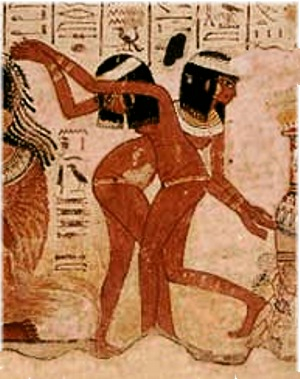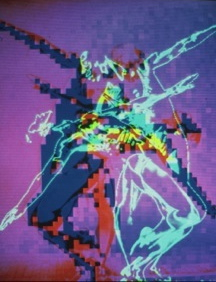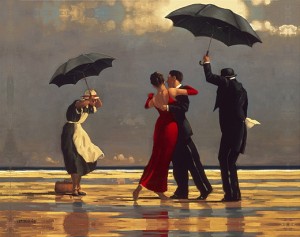Dance has long been considered the earliest art form, but it has been elusive to capture and difficult to document. Hence, scant records of dance movements exist.
Fortunately, artists throughout time have depicted dancers on cave walls, pottery, tapestries, marble, parchment, canvas, and most recently on computer screens.

Egyptian tomb mural, 3200 BC

Claudia and Clive (digital art), 1985 AD
Judith Gray
Some of the most intimately revealing paintings of dancers are those that present couples in each other’s arms.
Doris Humphrey, a pioneer of twentieth century modern dance, believed that “the lines of both dancers must be simplified and not appear contrived or complex so as to complement each other and not distract the viewer.”
Humphrey ardently felt that the dancer’s art had something to say which could not be expressed in words or in any other way than by dancing.
Could this be true? Haven’t the visual artists also captured this intimacy and simplicity in their paintings? What do you think?

Dance at Bougival, 1883
Pierre-Auguste Renoir

The Singing Butler, 1992
Jack Vettriano
Mikhail Baryshnikov and Gregory Hines dance their hearts out!
Click here if unable to view the video.
Guest Contributor: Judith A. Gray, Ph.D. National Dance Scholar award recipient and author of 3 dance books

Love this Kirby! I feel that dance and painting go together, the colors dance around in the canvas. I, the painter dance while painting. The connection between the viewer and the work is a dance as is life. Moving in and out, around an about…
Fabulous variety of dance images selected and interesting questions posed!
As I recall, LIFE is a dance. My personal experience of dancing is a class in “ballroom dancing” we were required to take at West Point. I passed; I certainly did not excel. Neither did I ever contemplate dancing while painting. (I’m not an artist either.)
It is possible that the skilled and perceptive artist can capture much of the magic of dancing in a painting; however, dancing is not painting any more than painting is dancing, although you can dance while you paint, just as you can paint while you dance. Ah… LIFE!
The images of dance are wonderful and they do” possibly” convey the emotions between the couples–however there is still nothing quite like seeing,experiencing and preforming the real thing (as proven by the video you provided)
Therefore I would say that is a tough one that hasn’t been totally captured in these images-
I absolutely agree, Stephen. As a former dancer, I understand your argument. When I am in the audience I vicariously and kinesthetically experience many of the emotions of the dancers – some of which would would be artistically challenging to capture in a painting.
“I suspect that humans were dancing as they evolved from dancing animals. It seems to me that animals dance – mating dance, territorial post.marking acts, etc.
Animals also sing – birds, etc. They also make non song rythmic noise that is a form of music.
Is is possible that song and rythym were also art forms that predated dance?”
Great question, Tom. According to interpretations of cave drawings, there is reason to believe that ritualistic movement (dance?) was customary in early human communities. Hunter gatherer societies had incentives to celebrate life’s joys, to denounce life’s tragedies and to invoke supernatural presence in ways that involved expressive movement (dance?) in which song and rhythm were undoubtably integral.
I have to vote for Humphrey’s view. I just watched the video, and during the impact of it, my heart pounded a bit faster and I had some adrenalin going on. That didn’t happen as I looked at the paintings, which gave me a smile and a much more quiet feeling. Thanks for this whole package of enjoying art and thinking about it!
All the forms cited are meaningful, enhance the human spirit, and permit individual enjoyment. Classical ballet, to which I have limited exposure, is one my favorites. The combination of grace, the human figure glorified, musical enhancement, and agility, I find exciting. But if to choose between art, the written word, and dance, the choice is easy – art.
Dancing feels like an exhuberance of excitment, a sort of release of being captured in the body. Rythmn and feeling a beat ,being a part of the beat. Dancing for joy and excitment is a personal thing . Dancing to amuse others is nice too, especially being paid to do it!!
Josephine, your prose is lovely! thank you for commenting.
Kirby